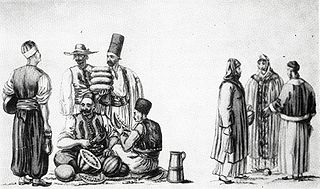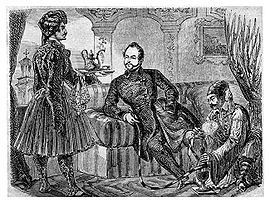
Suditi
Encyclopedia
For the commune in Ialomiţa County
, see Sudiţi, Ialomiţa
. For the villages in Buzău County
, see Gherăseni
and Poşta Câlnău
.
 The Sudiţi (plural of Sudit - Romanian language
The Sudiţi (plural of Sudit - Romanian language
, from Italian
suddito, meaning "subject" or "citizen
") were inhabitants of the Danubian Principalities
(Wallachia
and Moldavia
) who, for the latter stage of the 18th and a large part of the 19th century — during and after the Phanariote period of rule, were placed under the protection of foreign states (usually the Habsburg Monarchy
, Imperial Russia, and France
) as reward for particular services or in exchange for payment.
Rights acquired included immunity from prosecution in front of both local rulers (hospodars) and the Principalities' suzerain
power, the Ottoman Empire
, as well as tax exemption
s; the competing interests of nations involved allowed consuls to traffic sudiţi favours and titles.
, which led to the creation of foreign consulates
in Iaşi
and Bucharest
.
An expanding and powerful social category during the Russo-Turkish wars
(which affected the Principalities' soil), many sudiţi were wholesale
businessmen who formed guild
s (bresle or isnafuri) and successfully competed with Romanians
in several fields (after the Treaty of Adrianople
in 1829 allowed the two countries to engage in foreign trade), expanding during the period of Russian administration
(1828-1857).
 Notable sudiţi included Tudor Vladimirescu
Notable sudiţi included Tudor Vladimirescu
and Dimitrie Macedonski
, leaders of the 1821 Wallachian uprising
, as well as Ashkenazi Jews
who had left various regions in Russia and the Austrian
-ruled Kingdom of Galicia and Lodomeria.
The category disappeared after the 1878 Romanian War of Independence
.
Ialomita County
Ialomița is a county of Romania, in Muntenia, with the capital city at Slobozia.-Demographics:In 2002, it had a population of 296,572 and the population density was 67/km²....
, see Sudiţi, Ialomiţa
Suditi, Ialomita
Sudiţi is a commune located in Ialomiţa County, Romania. It is composed of two villages, Gura Văii and Sudiţi....
. For the villages in Buzău County
Buzau County
Buzău is a county of Romania, in the historical region Muntenia, with the capital city at Buzău.-Demographics:In 2002, it had a population of 496,214 and the population density was 81/km².*Romanians – 97%*Roma – under 3% declared, and others....
, see Gherăseni
Gheraseni
Gherăseni is a commune in Buzău County, Romania, 17 km south-east of Buzău, the county capital. It is composed of three villages: Gherăseni, Cremenea and Sudiţi.-Location:Gherăseni is located on the Bărăgan plain...
and Poşta Câlnău
Posta Câlnau
Poşta Câlnău is a commune in Buzău County, Romania. It is composed of six villages: Aliceni, Coconari, Poşta Câlnău, Potârnicheşti, Sudiţi and Zilişteanca....
.

Romanian language
Romanian Romanian Romanian (or Daco-Romanian; obsolete spellings Rumanian, Roumanian; self-designation: română, limba română ("the Romanian language") or românește (lit. "in Romanian") is a Romance language spoken by around 24 to 28 million people, primarily in Romania and Moldova...
, from Italian
Italian language
Italian is a Romance language spoken mainly in Europe: Italy, Switzerland, San Marino, Vatican City, by minorities in Malta, Monaco, Croatia, Slovenia, France, Libya, Eritrea, and Somalia, and by immigrant communities in the Americas and Australia...
suddito, meaning "subject" or "citizen
Citizenship
Citizenship is the state of being a citizen of a particular social, political, national, or human resource community. Citizenship status, under social contract theory, carries with it both rights and responsibilities...
") were inhabitants of the Danubian Principalities
Danubian Principalities
Danubian Principalities was a conventional name given to the Principalities of Moldavia and Wallachia, which emerged in the early 14th century. The term was coined in the Habsburg Monarchy after the Treaty of Küçük Kaynarca in order to designate an area on the lower Danube with a common...
(Wallachia
Wallachia
Wallachia or Walachia is a historical and geographical region of Romania. It is situated north of the Danube and south of the Southern Carpathians...
and Moldavia
Moldavia
Moldavia is a geographic and historical region and former principality in Eastern Europe, corresponding to the territory between the Eastern Carpathians and the Dniester river...
) who, for the latter stage of the 18th and a large part of the 19th century — during and after the Phanariote period of rule, were placed under the protection of foreign states (usually the Habsburg Monarchy
Habsburg Monarchy
The Habsburg Monarchy covered the territories ruled by the junior Austrian branch of the House of Habsburg , and then by the successor House of Habsburg-Lorraine , between 1526 and 1867/1918. The Imperial capital was Vienna, except from 1583 to 1611, when it was moved to Prague...
, Imperial Russia, and France
France
The French Republic , The French Republic , The French Republic , (commonly known as France , is a unitary semi-presidential republic in Western Europe with several overseas territories and islands located on other continents and in the Indian, Pacific, and Atlantic oceans. Metropolitan France...
) as reward for particular services or in exchange for payment.
Rights acquired included immunity from prosecution in front of both local rulers (hospodars) and the Principalities' suzerain
Suzerainty
Suzerainty occurs where a region or people is a tributary to a more powerful entity which controls its foreign affairs while allowing the tributary vassal state some limited domestic autonomy. The dominant entity in the suzerainty relationship, or the more powerful entity itself, is called a...
power, the Ottoman Empire
Ottoman Empire
The Ottoman EmpireIt was usually referred to as the "Ottoman Empire", the "Turkish Empire", the "Ottoman Caliphate" or more commonly "Turkey" by its contemporaries...
, as well as tax exemption
Tax exemption
Various tax systems grant a tax exemption to certain organizations, persons, income, property or other items taxable under the system. Tax exemption may also refer to a personal allowance or specific monetary exemption which may be claimed by an individual to reduce taxable income under some...
s; the competing interests of nations involved allowed consuls to traffic sudiţi favours and titles.
History
The category was established by the 1774 Treaty of Kucuk KaynarcaTreaty of Kucuk Kaynarca
The Treaty of Küçük Kaynarca was signed on 21 July 1774, in Küçük Kaynarca , Dobruja between the Russian Empire and the Ottoman Empire after the Ottoman Empire was defeated in the...
, which led to the creation of foreign consulates
Consul (representative)
The political title Consul is used for the official representatives of the government of one state in the territory of another, normally acting to assist and protect the citizens of the consul's own country, and to facilitate trade and friendship between the peoples of the two countries...
in Iaşi
Iasi
Iași is the second most populous city and a municipality in Romania. Located in the historical Moldavia region, Iași has traditionally been one of the leading centres of Romanian social, cultural, academic and artistic life...
and Bucharest
Bucharest
Bucharest is the capital municipality, cultural, industrial, and financial centre of Romania. It is the largest city in Romania, located in the southeast of the country, at , and lies on the banks of the Dâmbovița River....
.
An expanding and powerful social category during the Russo-Turkish wars
History of the Russo-Turkish wars
The Russo-Turkish wars were a series of wars fought between the Russian Empire and the Ottoman Empire during the 16th, 17th, 18th, 19th and 20th centuries...
(which affected the Principalities' soil), many sudiţi were wholesale
Wholesale
Wholesaling, jobbing, or distributing is defined as the sale of goods or merchandise to retailers, to industrial, commercial, institutional, or other professional business users, or to other wholesalers and related subordinated services...
businessmen who formed guild
Guild
A guild is an association of craftsmen in a particular trade. The earliest types of guild were formed as confraternities of workers. They were organized in a manner something between a trade union, a cartel, and a secret society...
s (bresle or isnafuri) and successfully competed with Romanians
Romanians
The Romanians are an ethnic group native to Romania, who speak Romanian; they are the majority inhabitants of Romania....
in several fields (after the Treaty of Adrianople
Treaty of Adrianople
The Peace Treaty of Adrianople concluded the Russo-Turkish War, 1828-1829 between Russia and the Ottoman Empire. It was signed on September 14, 1829 in Adrianople by Russia's Count Alexey Fyodorovich Orlov and by Turkey's Abdul Kadyr-bey...
in 1829 allowed the two countries to engage in foreign trade), expanding during the period of Russian administration
Regulamentul Organic
Regulamentul Organic was a quasi-constitutional organic law enforced in 1834–1835 by the Imperial Russian authorities in Moldavia and Wallachia...
(1828-1857).

Tudor Vladimirescu
Tudor Vladimirescu was a Wallachian Romanian revolutionary hero, the leader of the Wallachian uprising of 1821 and of the Pandur militia. He is also known as Tudor din Vladimiri or — occasionally — as Domnul Tudor .-Background:Tudor was born in Vladimiri, Gorj County in a family of landed peasants...
and Dimitrie Macedonski
Dimitrie Macedonski
Dimitrie Macedonski was a Wallachian Pandur captain and revolutionary leader. Taking part in the Wallachian uprising of 1821, he was appointed Tudor Vladimirescu's lieutenant by boyar allies of the revolutionaries, on January 15...
, leaders of the 1821 Wallachian uprising
Wallachian uprising of 1821
The Wallachian uprising of 1821 was an uprising in Wallachia against Ottoman rule which took place during 1821.-Background:...
, as well as Ashkenazi Jews
Ashkenazi Jews
Ashkenazi Jews, also known as Ashkenazic Jews or Ashkenazim , are the Jews descended from the medieval Jewish communities along the Rhine in Germany from Alsace in the south to the Rhineland in the north. Ashkenaz is the medieval Hebrew name for this region and thus for Germany...
who had left various regions in Russia and the Austrian
Austrian Empire
The Austrian Empire was a modern era successor empire, which was centered on what is today's Austria and which officially lasted from 1804 to 1867. It was followed by the Empire of Austria-Hungary, whose proclamation was a diplomatic move that elevated Hungary's status within the Austrian Empire...
-ruled Kingdom of Galicia and Lodomeria.
The category disappeared after the 1878 Romanian War of Independence
Romanian War of Independence
The Romanian War of Independence is the name used in Romanian historiography to refer to the 1877-1878 Russo-Turkish war, following which Romania, fighting on the Russian side, gained independence from the Ottoman Empire...
.

